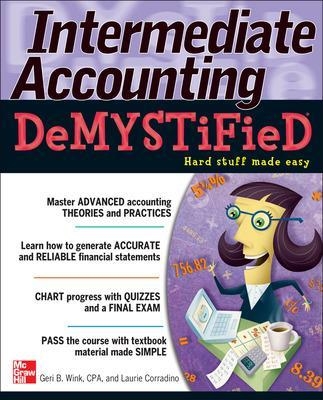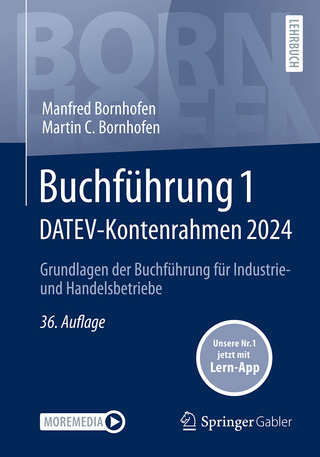
Intermediate Accounting DeMYSTiFieD
McGraw-Hill Professional (Verlag)
978-0-07-173885-9 (ISBN)
Accounting as easy as 1-2-3!Do you know the difference between FIFO and LIFO? Can you use the word dilutive in a sentence? Does thephrase "amortization of bond premiums" mean anything to you? No one said the journey to becoming a CPA is easy--but with Intermediate Accounting DeMYSTiFieD as your travel companion, you're guaranteed a smooth ride.An easy-to-use self-teaching guide that reviews andexpands upon core Generally Accepted Accounting Principles (GAAP), Intermediate Accounting DeMYSTiFieD covers everything you need to ace your exams and take a big step toward the career of your dreams. The book provides a fresh review of all the basics, so you can easily glide into more advanced principles. You'll learn how to generateaccurate and reliable financial statements, maintain proper internal controls within a company, and locate international accounting standards.This fast and easy guide offers:
Tactics for maintaining solid internal controls within a businessStrategies for creating accurate financial statementsTechniques for overcoming common accounting errorsQuizzes and a final exam for gauging what you've learnedTips and examples for mastering more advanced accounting theories
Simple enough for a novice but challenging enough for a veteran CPA, Intermediate Accounting DeMYSTiFieD is a shortcut to decoding key accounting concepts and principles.
Geri Wink, CPA, is a lecturer in intermediate accounting at the Hasan School of Business, Colorado State University-Pueblo and also works as a Certified Public Accountant in both Colorado and Texas Her work has been published in Oil and Gas Quarterly and The Management Accountant. Laurie Corradino is a student member of the American Institute of Certified Public Accountants, the Colorado Society of Certified Public Accountants, and other professional accounting organizations.
Section 1: The Balance Sheet – Assets: What Do I Own?
Chapter 1. Cash
a. Financial Statement Presentation
b. Internal Controls
c. Bank Reconciliations
Chapter 2. Inventory
a. Financial Statement Presentation
b. Internal Controls
c. FIFO, LIFO, Average Cost, Specific Identification
d. Estimation Methods (Gross Profit, Retail Method)
Chapter 3. Long Term Receivables
a. Financial Statement Presentation
b. Internal Controls
c. Journal Entries
Chapter 4. Investments
a. Financial Statement Presentation
b. Internal Controls
c. Fair Value vs. Cost
d. Investments in Temporary Securities
e. Investments in Available For Sale Securities
f. Investments in Debt Held to Maturity
Chapter 5. Property, Plant, and Equipment
a. Financial Statement Presentation
b. Internal Controls
c. Acquisition Methods
d. Costs After Acquisition
e. Depreciation, Depletion
Chapter 6. Intangibles
a. Financial Statement Presentation
b. Internal Controls
c. Acquisition Methods
d. Costs After Acquisition
e. Amortization
Section 2: The Balance Sheet – Liabilities: What Do I Owe?
Chapter 7. Current Liabilities
a. Financial Statement Presentation
b. Internal Controls
c. Contingencies
Chapter 8. Long Term Liabilities
a. Financial Statement Presentationb. Internal Controlsc. Bonds Payable (Issued at par, premium, discount; Amortization of premium and discounts)
Section 3: The Balance Sheet – Stockholder's Equity: What Is Left Over?
Chapter 9. Contributed Capital
a. Financial Statement Presentation
b. Internal Controls
c. Common Stock (Characteristics; Journal Entries for Issuance)
d. Preferred Stock (Characteristics; Journal Entries for Issuance)
e. Treasury Stock (Par Value Method; Cost Method)
f. Compensatory Stock Options
Chapter 10. Earnings Per Share
a. Financial Statement Presentation
b. Capital Structures
c. Basic EPS
d. Diluted EPS
Chapter 11. Retained Earnings
a. Financial Statement Presentation
b. Dividends (Cash Dividends; Property Dividends; Scrip Dividends; Stock Dividends; Liquidating Dividends)
Section 4: The Income Statement: How Much Have I Earned?
Chapter 12. Income Measurement
a. Financial Statement Presentationb. Internal Controlsc. General Rule (Cash Basis; Accrual Basis)d. Exceptions to the General Rule (Revenue Recognized Prior to Sale--Percentage of Completion Method & Completed Contract Method; Revenue Recognized After the Sale--Installment Method & Cost Recovery Method)
Chapter 13. Income Taxes
a. Financial Statement Presentation
b. Permanent Differences
c. Temporary Differences
d. Deferred Tax Assets
e. Deferred Tax Liabilities
Chapter 14. Pensions
a. Financial Statement Presentation
b. Defined Benefit Pension Plans
c. Defined Contribution Pension Plans
Chapter 15. Leases
a. Financial Statement Presentation
b. Operating Lease
c. Capital Lease from the Lessee's Perspective
d. Capital Lease from the Lessor's Perspective
e. Sale Leaseback Section 5: The Statement of Cash Flows: Where's the Cash?
Chapter 16. Statement of Cash Flows
a. Financial Statement Presentation
b. Indirect Method
c. Direct Method
Section 6: Additional Tough Topics Made Easy
Chapter 17. Accounting Changes and Errors
a. Financial Statement Presentationb. Types of Accounting Changes and Errors (Change in Accounting Principle--General Rule and Exceptions to the General Rule; Change in Estimate; Errors)
Chapter 18. International Accounting Standards
a. Current Status
| Erscheint lt. Verlag | 16.1.2011 |
|---|---|
| Zusatzinfo | 30 Illustrations |
| Sprache | englisch |
| Maße | 185 x 231 mm |
| Gewicht | 656 g |
| Themenwelt | Wirtschaft ► Betriebswirtschaft / Management ► Rechnungswesen / Bilanzen |
| ISBN-10 | 0-07-173885-1 / 0071738851 |
| ISBN-13 | 978-0-07-173885-9 / 9780071738859 |
| Zustand | Neuware |
| Informationen gemäß Produktsicherheitsverordnung (GPSR) | |
| Haben Sie eine Frage zum Produkt? |
aus dem Bereich


